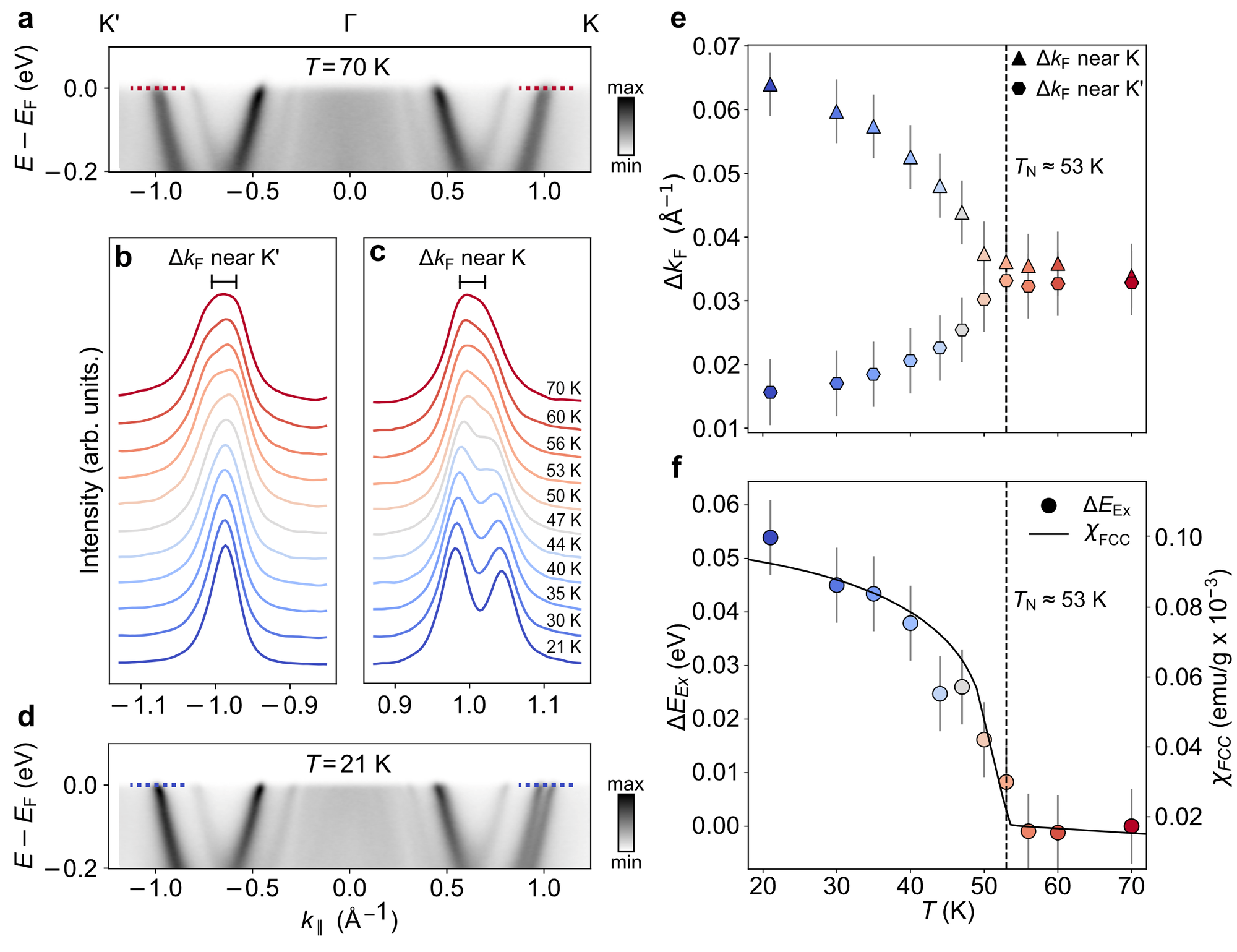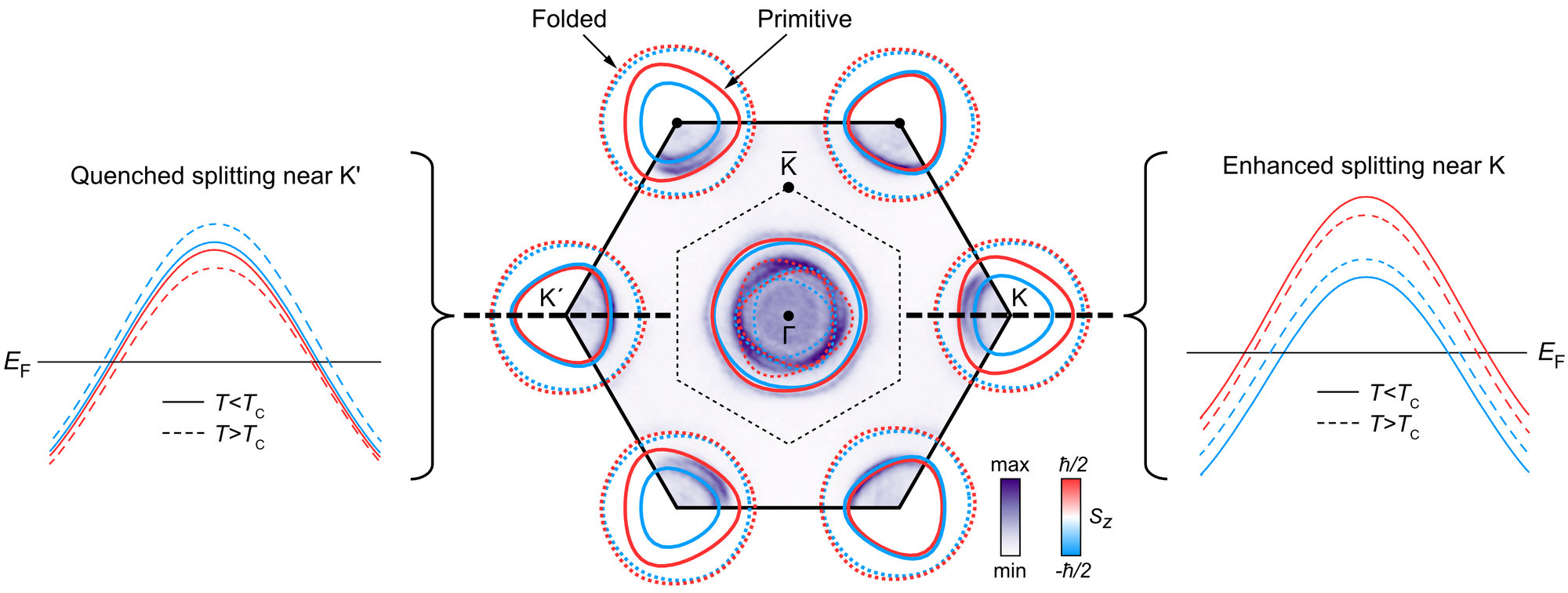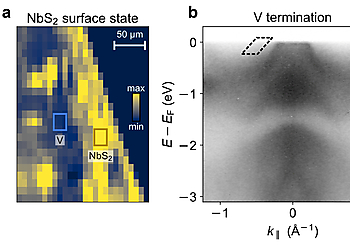Giant valley-Zeeman coupling in the surface layer of an intercalated transition-metal dichalcogenide
Result of the Month
Intercalating guest atoms into the van der Waals gaps of transition-metal dichalcogenides has emerged as a powerful route to tune their already flexible material properties. In superconducting NbS2, intercalating magnetic (M=V, Cr, Co, Fe) ions leads to the development of long-range magnetic orders hosting non-trivial spin textures. For a critical composition of M1/3NbS2, the intercalated atoms arrange periodically in a superstructure, making the crystal non-centrosymmetric. Here, we consider the case of V1/3NbS2, where below a critical temperature, TN ≈ 50 K, the V spins order, forming a canted antiferromagnetic state which is reported to lead to a net uncompensated ferromagnetic moment.
By performing spatially-resolved µ-ARPES and XPS measurements at the Bloch beamline of MAX-IV, with a spot size of just 10 × 15 µm2, we characterised the distinct surface termination-dependent electronic structures of V1/3NbS2. Upon sample cleavage, both V and NbS2 surface terminations are obtained, randomly distributed across the sample. Marked variations in the measured electronic structure are observed between the two terminations, with NbS2 surface terminations exhibiting clear signatures for a range of dispersive states which are derived from the surface NbS2 layer. Intriguingly, our measurements from individual magnetic domains indicate that these states support a strongly anisotropic splitting, leading to a strongly valley-dependent Fermi surface splitting.

FIG. 2 - Temperature-dependent electronic structure of the NbS2-terminated surface. (a-d) ARPES measurements along K’-Γ-K (hν = 70 eV, polarization = LH, PE = 10 eV, lens mode = DA30L_01). Dispersions measured at (a) 70 K and (d) 21 K, and (b,c) temperature-dependent Fermi level MDCs (taken along the dashed lines shown in a and d) indicate the development of an anisotropic band splitting for positive and negative momenta below the magnetic ordering temperature, as evident in the momentum splittings at the Fermi level, DkF, extracted from fits to the MDCs (e), pointing to a pronounced exchange splitting onsetting below TN. (f) The temperature-dependent exchange splitting extracted from analysis of this data closely follows the bulk magnetic susceptibility.
To explore this surface NbS2 layer valley-dependent spin splitting further, we measured the temperature-dependent electronic structure and modelled the system as a surface NbS2 layer coupled with the underlying magnetic V interacted atoms. We showed that this valley-dependent spin splitting originates from a giant valley-Zeeman coupling effect at the surface, exceeding 50 meV. Key to this giant effect is the strong RKKY-like coupling between the magnetic and itinerant layers.

FIG. 3 - Giant valley-Zeeman interactions in the surface NbS2 layer. The above results can be understood from a combination of magnetic proximity coupling and valley-dependent spin-orbit mediated splittings. At the K point, these act co-operatively, enhancing the spin splitting in the electronic states of the surface NbS2 layer (right), while at K’, they work in opposition, with the resulting band splitting being nearly completely quenched (left). Calculations of this effect reproduce the experimentally-measured Fermi surface extremely well (centre).
Together, our measurements and calculations establish a new route to control valley spin splittings, via a highly-integrated bulk-surface approach that provides by far the largest proximity coupling of a TMD monolayer realised to date. These splittings can be readily tuned by modest changes in temperature and provide substantially larger responses compared to other proximity-coupling schemes utilised to date. Excitingly, there is a large and rich family of intercalated TMDs, hosting distinct TMD layers, magnetic orders and critical temperatures. This raises the tantalising prospect to gain additional control over spin splittings in monolayer-like TMDs, and to couple the effects observed here with other collective states.
METHODS
Spatially-resolved µ-ARPES and XPS measurements were performed at the Bloch beamline of MAX IV Laboratory. Single-crystal samples were mounted on a 6-axis manipulator which allowed cooling to 19 K. The samples were cleaved in situ at base temperature, and measured with a Scienta DA30-L electron analyser, using linearly-polarised light with photon energies between 25 and 200 eV, and with a probing spot size of 10 × 15 µm2.
---
AUTHORS:
B. Edwards1, O. Dowinton2, A. E. Hall3, P. A. E. Murgatroyd1, S. Buchberger1,4, T. Antonelli1, G.-R. Siemann1, A. Rajan1, E. Abarca Morales1,4, A. Zivanovic1,4, C. Bigi1, R. V. Belosludov5, C. M. Polley6, D. Carbone6, D. A. Mayoh3, G. Balakrishnan3, M. S. Bahramy2,*, P. D. C. King1,*
---
INSTITUTE:
1 - SUPA, School of Physics and Astronomy, University of St Andrews, St Andrews KY16 9SS, UK
2 - Department of Physics and Astronomy, University of Manchester, Oxford Road, Manchester M13 9PL, UK
3 - Department of Physics, University of Warwick, Coventry CV4 7AL, United Kingdom
4 - Max Planck Institute for Chemical Physics of Solids, Nöthnitzer Strasse 40, 01187 Dresden, Germany
5- Institute for Materials Research, Tohoku University, Sendai 980-08577 Japan
6 - MAX IV Laboratory, Lund University, P. O. Box 118, 221 00 Lund, Sweden
---
CORRESPONDING AUTHORS:
Phil D C King: pdk6@st-andrews.ac.uk
Mohammad Saeed Bahramy: m.saeed.bahramy@manchester.ac.uk
---
JOURNAL AND LINK TO PUBLICATION:
Nature Materials: https://www.nature.com/articles/s41563-022-01459-z
Publication:https://doi.org/10.1038/s41563-022-01459-z

